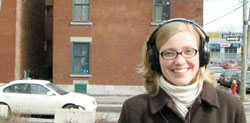Hear, Here: Griffintown echoes with past

Communications MA student Lisa Gasior has been recording the history of Griffintown along with the sounds of the changing neighbourhood.
jacob larsen
If you didn't know what you were looking for, you might walk right through it without ever noticing.
The neighbourhood of Griffintown — sandwiched along the Lachine Canal between Little Burgundy and the Old Port — was once the focal point of industry lining the Canal and the home of Montreal's Irish-Catholic working class. Now, Griffintown lives on mostly in the memories of former residents.
A cultural revival of sorts is taking place in Griffintown, and two Concordia grad students are there to tell its story.
Using a creative blend of audio recordings and narrative, Lisa Gasior, an MA student in Media and Communication Studies, is articulating a new way of exploring our urban experience. With interviews from past and present residents, sounds from the neighbourhood and some of her own observations, Gasior is composing a soundscape of Griffintown.
As she explains, soundscapes were developed in the 1970s by scholars who used sound recording as a way to critique urban noise pollution. But in her work with soundscapes, she is trying to change that.
“There’s noise in [urban] soundscapes, but there’s beauty in it, too.”
Griffintown is in many ways the perfect setting for exploring the urban soundscape. The clip-clop of horses that pull tourists around the Old Port intermingle with the rumblings of light industry and the cacophony of condo construction. Here, the past and present merge seamlessly, and the future bangs impatiently to be let in.
Matthew Barlow is also interested in the role of memory in understanding Griffintown’s stages of metamorphosis. Describing his work in an email interview, he wrote: “The dissertation is an examination of place and identity, Griffintown and Irishness from about 1870 to about 10 minutes ago. I trace the arc of Irish-Catholic identity amongst the residents of this working class neighbourhood over this long durée.”
Unlike Gasior, however, Barlow has chosen not to conduct his research using interviews with the aging Griffintowners. As he explains, his decision not to engage this potentially rich vein of historical memory was an ethical one.
“If you think about the dynamics of doing oral history, you are asking people for their stories, and they are entrusting you with these stories, and this is a pretty heavy thing.”
However, by examining the process of commemoration underway in the community, Barlow found that Griffintown was a site of symbolic memory for aspects of Montreal's Irish community. Through his research, Barlow has found that “the symbolic idea of the neighbourhood, of the landscape, becomes a repository of their memories.”
Barlow’s own family traces its history through Griffintown, but this is only part of his interest in studying the community.
“I feel the need to document the history of this neighbourhood before we're left with something else entirely in the form of redevelopment,” he explains.
That interest definitely shared by past residents currently resurrecting the memories of their old neighbourhood.
“They're reaching their sixties and seventies, and they have been presented with a prime opportunity to recall their lives and histories there, and I think that's pretty important.”